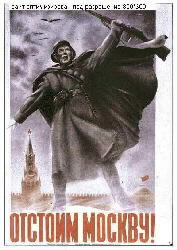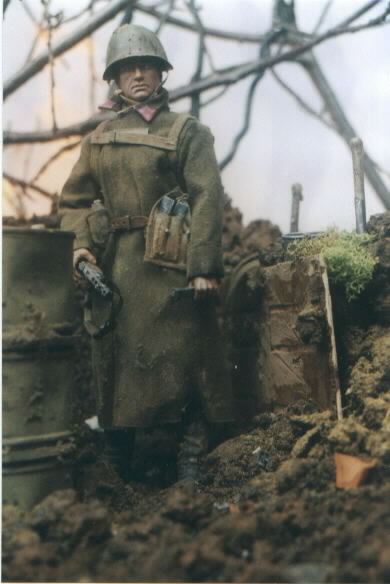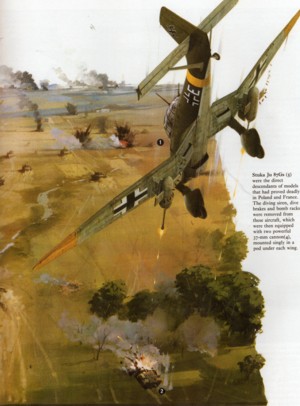|
|
Germany pits her might against Russia.
The skies of eastern Europe were streaked with the blood red of dawn on Sunday, June 22,1941, when Adolf Hitler unleashed his war hungry legions on the 2,000 mile Russian frontier, from the White to the Black Sea. Dwarfing man's prior conception of war, the victory drunk Reichsfuchrer hurled the full power of his military machine against massive Russia, gambling on a swift surge of conquest to make the Soviet Union his serf, destroy the threat to his eastern flank and fatten his empire for domonation of Europe.
The German debacle in Russia is the epic story of the Red Army. It is the saga of millions of men and woman who, though faced with the engulfing might of a reputedly unconquerable war machine, pitted the naked courage of their zeal against the fanatical crusading fury of a self-anointed "super race." Outnumbered at first, outgunned, outweighed in armor and overwhelmed in the air, outmaneuevred and out fought, the Soviet's stalwart defenders were thrown back. The tide would turn though, the Red Army would dig in, stall, hit and run, until the Huns were thrown back to the borders of the motherland, and finally all the way back to Berlin.
|

"The military decision has already fallen. Soviet Russia is done with. The British dream of a two front war is dead." Thus spoke Dr. Otto Dietrich, the German press spokesman, when he returned to Berlin on, October 9, 1941. He did not speak out of hand. The Red Army was reeling on all fronts.
Moscow acknowledged the fall of Orel, 200 miles from the capital and admitted German pressure was heavy. Capture of Odessa by German and Rumanian troops was proclaimed by Hitler on October 16. On October 30, after a 10 day battle, the Germans cracked the perekop wall and streamed down through the Crimea, toward Kerch, opposite the Caucasus, and Sevastopol a main base of the Red Navy in the Black Sea. The Germans seemed unstoppable, but with the timing that marked the Red Army's notable feats, they were ready for the moment of the siege floods ebb.
Carefully calculated Russian plans for a decisive counterattack were set in motion on December 4. Heavy reserves had been drawn in from the east, together with a large quota of new tanks, other armoured vehicles and guns. The temperture stood at 13 degrees below zero. The Germans benumbed with cold and debilitated by the fatique of their long effort, were in poor condition to meet the Russian's thundering blows. At first they buckled from the pressure and then recovered. The Red Army sensing victory touxiang, hit them again. This time they collapsed, the humiliated German's plodded westward in Napolean's very footsteps.
|
 Aleksii - 13th Guards Division. Seen here on the banks of the Volga.
Aleksii - 13th Guards Division. Seen here on the banks of the Volga.
Created by Sixth Scale Battle.
Aleksii, is a member of the elite 13th Guards Division. His division has been sent across the Volga into Stalingrad just in time to repel a German attack that had reached the river, near the center of the city, 30% of the 10,000 men of his division were killed in the first 24 hours of their arrival, and only 320 men of the division survived the Battle of Stalingrad, a horrible 97% death rate, but they saved Stalingrad in the most critical moment.
Aleksii, is one of the 320 that survived. He is seen here in a redoubt on the banks of the Volga. It is three weeks before the end of the Battle of Stalingrad, and three years before the end of the war. Aleksii, will go home to his wife, they will have six children together and he will never tire of telling stories to his grandchildren.
Fact: 80% of Soviet males born in 1923 didn't survive WWII |

The Battle Of Kursk.
In the winter and spring of 1943, after their terrible defeat in Stalingrad, clearly outnumbered and losing the initiative in the eastern front, Hitler and the german high command were asking themselves what to do next.
The situation was bad not only in the war front. While russian tank production increased to unbelievable levels, the german obsession for complex new super weapons, like the advanced but then immature Panther and Tiger tanks, largely reduced german tank production. General guderian, the best german armor expert and commander, said "As interesting as these designs were, the practical result was just a reduced production of the Panzer 4, our only efficient tank then, to a very modest level.". Shortly before the battle of Kursk Guderian added, about the Panther and its crews, "They are simply not ready yet for the front". In early 1943 the germans were about to destroy their own tank production rates by terminating Panzer 4 production in return for a production of just 25 new Tigers per month, but in a moment of reason Hitler gave control of tank production to Guderian who stopped this idea.
The German Plan
The debate in the german high command about what to do in the summer of 1943 was between two options, the realistic option and the enthusiast-optimist option:
The realistic option, supported by Guderian and Manstein, the best german field commanders, and by others, suggested to compensate for the large russian numerical advantage by fully utilizing the superiority of the german commanders and soldiers in tactics, command, and fighting, by a strategy of dynamic mobile defense that would cause great losses to the russians in a series of local clashes. The realistic goal was to stop and delay the russians, as decisive victory was no longer achievable.
The enthusiast-optimistic option, proposed by general Zeitzler, chief of staff of the german army, suggested to concentrate almost all german tanks, and other forces, to a major decisive battle against a large portion of the russian armor, in order to destroy them and by doing so hopefully regain the initiative. The most suitable place for such a battle, as Zeitzler proposed, was the kursk salient, a wide region around the city of Kursk, about half way between Moscow and the black sea, where the germans surrounded the russians from three sides. It was obvious that the russians will keep a large tank force there, and the plan was to encircle them in a classic blitzkrieg style pincer movement of german tanks from north and south and destroy them. Zeitzler's plan was code named Operation Citadel.
When Hitler discussed the two options with his generals in May 4th, exactly two months before the german attack began, it became clear that each of the two options had a major problem.
The major problem with Zeitzler's plan to attack the kursk salient, was that aerial photos clearly revealed that the russians were building dense and deep fortifications there in order to counter such an attack, and that many russian tanks were moved deeper behind the front line. Instead of an open battlefield blitzkrieg, it was going to be a direct charge at dense anti-tank defenses. General von Mellenthin warned that such a direct attack will be a "Totenritt", a ride to death, for the german tanks. In response to Guderian's worries, Hilter himself admitted that whenever he think of this planned attack, his guts turn.
The major problem with Guderian's option was that it lacked the charm, enthusiasm, and optimistic hope for a major change in the war that Zeitzler's plan had. So the enthusiast Hitler decided in favor of Zeitzler's plan, and calmed his worries of it by ordering to delay the attack for a while in order to incorporate more of the brand new advanced german tanks and tank destroyers in it. The date was set to July 4, 1943.
Once the order was given, the germans prepared as best as they could. The entire region was photographed from above, the german commanders visited the front line to observe their intended routes, and the germans concentrated all available forces in two armies, north and south of the kursk salient, leaving minimal forces along the rest of the long russian front.
The german force included a total of 50 divisions, including 17 armor and mechanized divisions. These included the most powerful and best equipped german divisions, such as the Gross Deutschland (Great Germany) division and the Waffen-SS tank divisions Leibstandarte (Hitler's bodyguards), Totenkopf (Death skull), and Das Reich (The Reich). The germans concentrated all their new armor, the Tiger and Panther tanks, and the mighty new Elefant tank destroyers, which had a front armor thicker than a battleship's armor. They also concentrated all available air units and artillery, and despite the problems of the german plan it was a formidable concentrated mobile armor force with great offensive potential.
The Russian Preparations
Thanks to their "Lucy" spy network, which operated high ranking sources in germany via Switzerland, the russians didn't just expect the german attack, they knew all about it. They received the full details of the german plan, and the russian military intelligence was able to verify most details in the front to ensure that the information was real, not disinformation.
The russians prepared eight defense lines one behind the other, and also positioned their entire strategic mobile reserve east of the kursk salient, in case the germans will penetrate thru all these defense lines, which indeed happened.
The russian plan was simple. First, they will let the germans attack as planned right into their series of very dense defense lines, and after the german armor will be crushed there, the russian army will start its strategic attack north and south of the kursk salient and push the germans west along a wide part of the front.
The russian defense was unprecedented in its density. A total of 1,300,000 russian soldiers with 3600 tanks, 20,000 guns, including 6000 76mm anti-tank guns, and 2400 aircraft were concentrated in and around the kursk salient. It was about a fifth of the russian military personnel, over a third of the tanks and over 1/4 of the aircraft. They laid 3400 mines per each kilometer of the front, half of them anti-tank mines, and over 300,000 civilians dug thousands of kilometers of anti-tank trenches and other fortifications. The russian lines were filled with numerous anti-tank guns organized in groups of up to 10, each group commanded by one officer and firing at the same target. The russian camouflage was superb, the germans said that until they were hit by them, they could identify neither the russian mine fields nor their anti-tank gun positions. To avoid forcing the germans to divert from their known plan, russian air attacks were delayed until the german tanks already moved into the trap. The russians were as ready as they could be.
The Battle of Kursk
The german attack finally began, in the afternoon of july 4, 1943, as planned. The german armor spearheads, led by the most armored and most powerful Tigers and Elefants, advanced forward in the wheat fields toward the russian lines. Then came wave after wave of anti-tank aircraft attacks by both sides, german Stukas attacked dug in russian tanks and russian Sturmoviks attacked the german tanks. The fighters of both sides engages in air combats over the battlefield, and each side's massive heavy artillery also fired. The advancing german tanks suffered rapidly increasing losses from the dense russian anti-tank defenses, but pressed forward. Once the german heavy tanks reached into the russian defense lines, they could finally be hit and destroyed from their sides, where they were not so armored as from the front. At this short range they also lost their superiority in long range firing from their powerful guns.
In the north, the german attack advanced only 10km into the russian lines in two days and was stopped, after losing about 25,000 soldiers and 200 tanks, but fighting continued. In the south, where they had stronger forces, the germans sent all their reserves forward and pressed on despite the losses.
On july 12, after a week of heavy fighting with heavy casualties in both sides, general Hoth, the german commander in the south side of the kursk salient, decided to concentrate all his remaining tanks, about 600, and press forward with all their concentrated force deeper, past the last remaining russian defense line, and into an area more suitable for tank warfare near the small village Prokhorovka.
He didn't know that at this point in the battle, the russian high command already predicted this development, and since the german advance in the north was stopped, they could now safely send their armor reserve to meet the advancing german tanks in the south. The russians ordered their entire 5th Guards tank army, which so far didn't participate in the battle, to hurry at maximum speed from its position east of kursk to meet the german tanks advancing near Prokhorovka.
Due to very bad visibility, with thick smoke and dust, when the russian tanks met the german tanks the next morning, they didn't stop advancing until they were all around and between them, so about 1500 german and russian tanks fought in a fierce battle of very short firing distances in which the germans could not exploit their technological superiority in longer range fighting. The germans lost more than half of their remaining tanks in this great clash which lasted eight hours, and the russians lost greater numbers. The battle was decided. The next day Hitler ordered to stop Operation Citadel, and the russians started their counter attack north of kursk.
After the battle
The battlefield in kursk was filled with many hundreds of burnt tanks and crashed aircraft, and so many dead soldiers. The difference was that while the russians suffered heavy losses but could continue as planned and shift from defense to a large counter attack in a wide front, the german army in the east just lost the core of its remaining force.
In the summer of 1941 the german army attacked russia and was stopped only near moscow. In the summer of 1942 the german army attacked in south russia and reached the volga river at stalingrad before it was stopped, and lost the strategic initiative to the recovering russian army. In the summer of 1943, in the battle of kursk, the much weaker german army broke its fist and lost its best remaining units in its attempt to regain the initiative in one last major attack, for which the russians were fully prepared.
After the battle of kursk, the war in the eastern front was a long russian advance, in which the russian army returned to all the territory it lost to the germans, conquered all of eastern europe, and reached all the way to germany and to Berlin and won the war. The germans could no longer attack or stop the russian advance, and were just pushed back in a long retreat.
|
|
|





